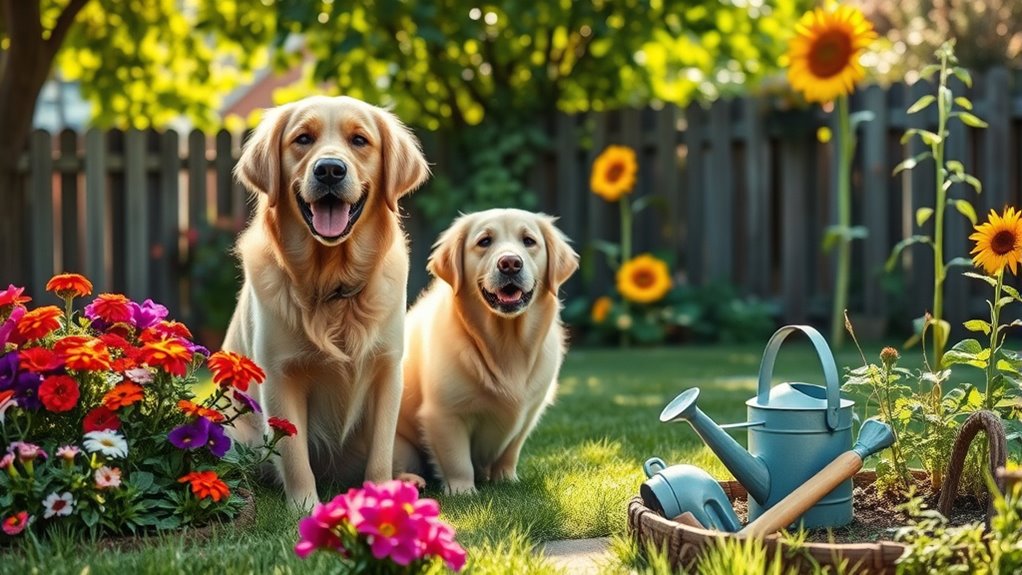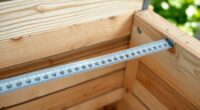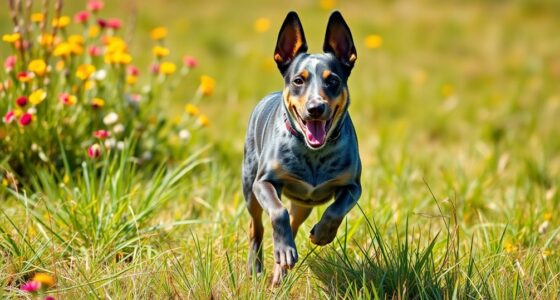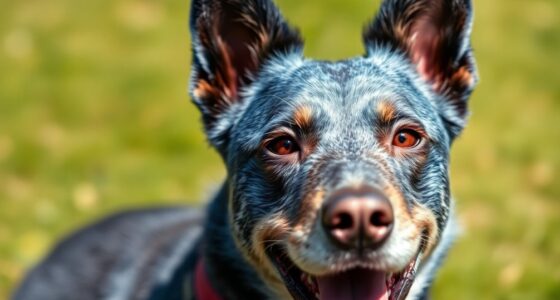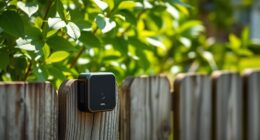To create a dog-friendly garden, choose non-toxic plants like marigolds and sunflowers, and avoid risky ones like lilies or azaleas. Designate a secure play area with tall, sturdy fencing and regular checks to prevent escapes. Use pet-safe mulch and ground covers, and steer clear of harmful chemicals or pesticides. Install dog-friendly water features and durable furniture. Keep toxic plants out of reach and maintain your garden to make sure it’s safe and inviting for your dog—there’s plenty more to discover!
Key Takeaways
- Use non-toxic, pet-safe plants like marigolds and sunflowers, and avoid toxic varieties such as lilies and azaleas.
- Install secure fencing with appropriate height and gates to prevent your dog from escaping.
- Choose pet-safe mulch and ground covers, avoiding cocoa mulch and materials that could be ingested or cause harm.
- Keep chemical pesticides, herbicides, and fertilizers out of reach, opting for natural pest control methods instead.
- Provide shaded, comfortable resting areas and ensure easy access to clean, fresh water in the garden.
Choose Non-Toxic Plants for Your Garden
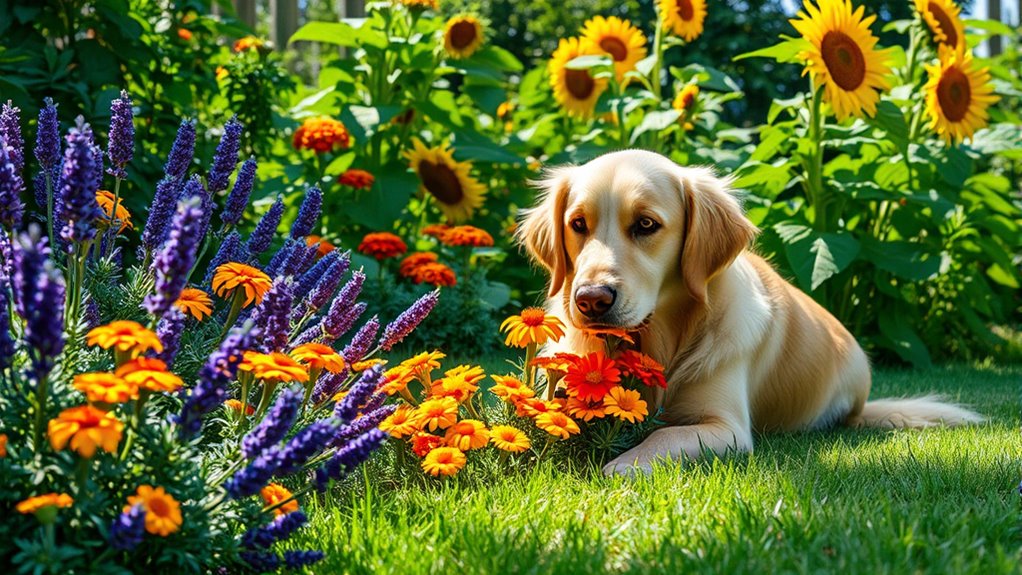
When creating a dog-friendly garden, selecting non-toxic plants is essential to keep your furry friend safe. Whether you’re designing a flower bed or a vegetable patch, choose plants that are non-toxic to dogs. Many common flowers, like marigolds and sunflowers, are safe options, while others such as lilies and azaleas pose risks. For your vegetable patch, stick to dog-safe vegetables like carrots, peas, and green beans, avoiding harmful plants like tomatoes and potatoes if you’re unsure. Incorporating non-toxic plants helps prevent accidental poisoning if your dog sniffs or chews on them. Additionally, understanding the toxicity levels of plants can help you make better choices for your garden’s safety. Knowing which plants are safe for dogs supports responsible gardening and peace of mind. Always double-check plant safety lists before planting, and consider consulting your vet for recommendations. Being aware of plant toxicity is crucial to ensure your garden remains a safe haven. Creating a designated dog-safe zone with non-toxic plants provides a dedicated space where your pet can play safely. By selecting the right plants, you create a beautiful, safe space that your dog can enjoy alongside your garden’s beauty.
Designate a Safe Play Area for Your Dog
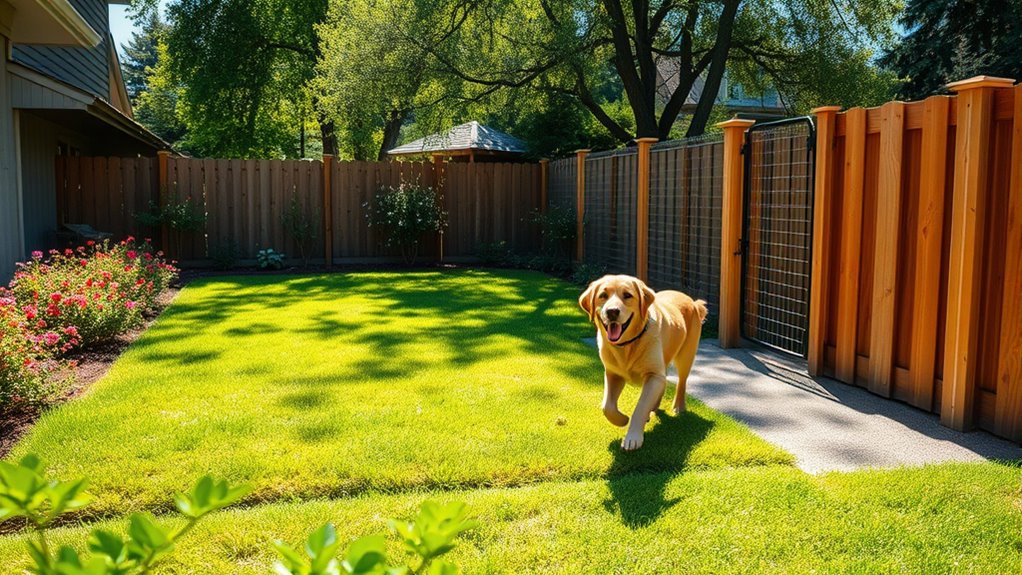
Creating a designated safe play area for your dog guarantees they can enjoy the garden without risking exposure to hazards or damaging plants. By establishing a specific space, you promote playground safety and prevent unwanted behavior elsewhere. Consider setting up dog agility zones with low hurdles or tunnels to keep your dog active and engaged. Make sure the area has secure fencing to prevent escapes and is free of toxic plants, sharp objects, or chemicals. Regularly inspect the space for hazards and keep it clean. Incorporate shaded spots and water stations to keep your dog comfortable during play. Maintaining a safe environment is essential for your pet’s health and happiness. Using appropriate fencing materials can enhance security and durability of the play area. A well-defined play area helps your dog burn off energy safely while protecting your garden’s beauty and your pet’s well-being. Additionally, including proper containment solutions ensures your dog remains within the designated safe zone and reduces the risk of wandering into harmful areas. Incorporating supervision and training can further reinforce boundaries and promote positive behavior during playtime. Implementing fencing with durability can also withstand weather conditions and active dogs, ensuring long-term safety.
Use Pet-Safe Mulch and Ground Cover
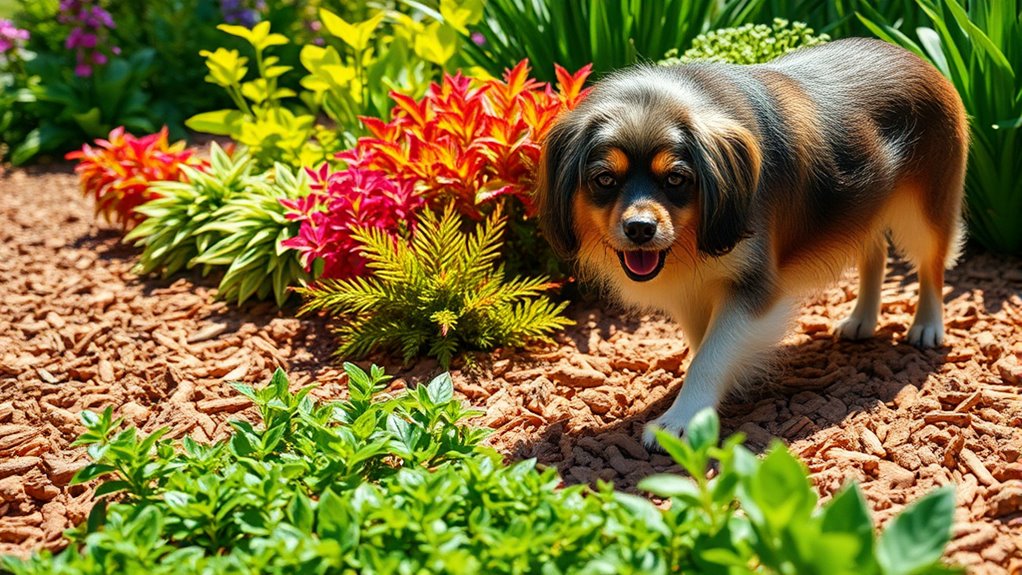
Choosing the right mulch and ground cover is key to maintaining a safe garden for your dog. Opt for pet-safe options like cedar or pine bark, which are less toxic and help with garden pest management. Avoid cocoa mulch, as it’s highly toxic to dogs. Using natural ground covers like clover or grass reduces the risk of ingestion and keeps soil healthy. Proper mulch selection also supports composting and soil health by preventing erosion and retaining moisture. Regularly inspect your mulch for mold or pests, and replace it when needed. This approach minimizes potential hazards, ensuring your dog can enjoy the garden safely while promoting a healthy environment for plants. Always prioritize safety and choose non-toxic, natural materials for ground cover. Additionally, selecting beneficial soil microbes can promote soil health and improve overall garden health. Incorporating organic fertilizers can further enhance soil fertility and plant growth, creating a thriving, pet-friendly garden.
Secure Fences and Boundaries
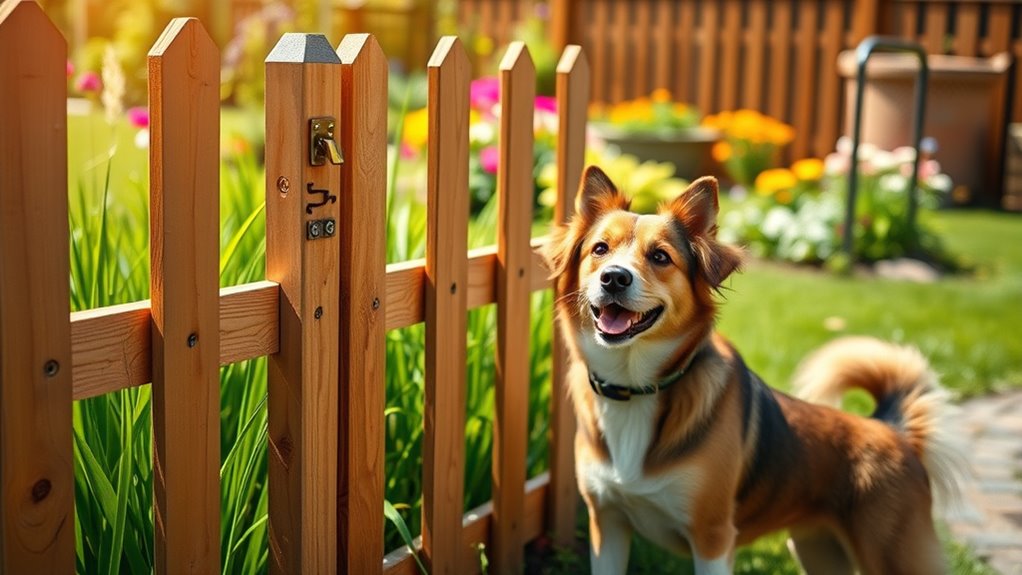
To keep your dog safe in the garden, guarantee your fences are sturdy and secure. Choose durable materials, check their height and gate locks regularly, and perform routine boundary maintenance. These steps help prevent your pet from escaping or getting into trouble. Additionally, inspecting your fence integrity regularly ensures that all components are in good condition and provides extra reassurance for your pet’s safety. Utilizing safety features like secure gate latches can further enhance enclosure security. Staying informed about digital literacy programs can also help in understanding and implementing modern safety options. Regularly updating your knowledge about security features and their proper use can significantly improve your pet’s safety in the outdoor space. Incorporating crochet styles for locs into your outdoor decor can create a welcoming environment for both pets and owners.
Durable Fence Materials
Ever wondered what makes a fence truly secure and long-lasting? Choosing durable fence materials is key. Opt for options like vinyl, metal, or pressure-treated wood, which withstand weather and pet activity. Make sure your fence is sturdy enough to contain your dog and resist wear over time. When planning, consider your garden soil and plant spacing — a strong fence helps protect delicate plants from curious paws. Proper installation ensures the fence remains intact, preventing escapes. Regular maintenance, like checking for loose panels or rust, extends its lifespan. For added security, ensure the materials are smooth without sharp edges that could hurt your dog. Incorporating material durability in your fencing choices can significantly enhance its lifespan and performance. Using weather-resistant materials can also help your fence endure seasonal changes and harsh conditions. Investing in quality, durable fencing creates a safe, secure boundary for your pet while preserving your garden’s beauty. Incorporating somatic awareness techniques in your routine can also help you better understand your dog’s stress signals and improve your overall pet care. Additionally, exploring advanced techniques for fence installation and maintenance can further ensure your boundary remains effective and safe over time.
Height and Gate Security
Ensuring your fence is tall enough is essential to prevent your dog from jumping over or sneaking through. Consider your garden layout and plant height when planning your boundary. Tall, dense plants near the fence can act as a natural barrier, making it harder for your dog to find a way out. Adjust the fence height based on your dog’s jumping ability; for most, a minimum of 6 feet is recommended. Gates should be secure and self-closing to prevent accidental escapes. Check that there are no gaps or weak spots in the fencing, especially around corners and gates. Proper height and gate security create a reliable boundary, keeping your dog safe while allowing your garden to flourish without the risk of escape. Incorporating fencing techniques that enhance security can further deter escape attempts and provide peace of mind, especially as automation and technology are increasingly used to monitor property boundaries. Additionally, choosing trustworthy fencing brands can ensure long-term durability and effectiveness in maintaining a secure enclosure.
Regular Boundary Maintenance
How often do you check your fences and boundaries to keep them secure? Regular maintenance is key to preventing your dog from escaping or getting into trouble. Start by inspecting your fences for any weak spots or damage, especially after storms or heavy weather. Conduct soil testing around your boundary lines to identify any erosion or instability that could compromise your fence’s foundation. Keep pest control in mind, as pests can weaken fence posts or create holes.
- Repair or reinforce damaged sections promptly
- Trim overgrown plants that may provide escape routes
- Test soil stability and consider reinforcements when needed
Consistent boundary upkeep guarantees your yard remains safe, secure, and dog-friendly.
Avoid Harmful Garden Chemicals and Pesticides

To keep your dog safe while gardening, it’s crucial to avoid using harmful chemicals and pesticides that can pose health risks. Instead, focus on natural garden pest control methods, such as introducing beneficial insects or using organic sprays. Be cautious with commercial pesticides, herbicides, and fungicides, as many contain toxins that can be harmful if ingested or absorbed through the skin. Incorporate safe composting techniques to enrich your soil without chemicals, reducing the need for chemical fertilizers. Proper composting not only minimizes waste but also promotes healthy plant growth without risking your dog’s exposure to harmful substances. Always read labels carefully and opt for pet-safe alternatives to keep your garden a safe haven for both your plants and your furry friend.
Create Shady Spots and Comfortable Rest Areas
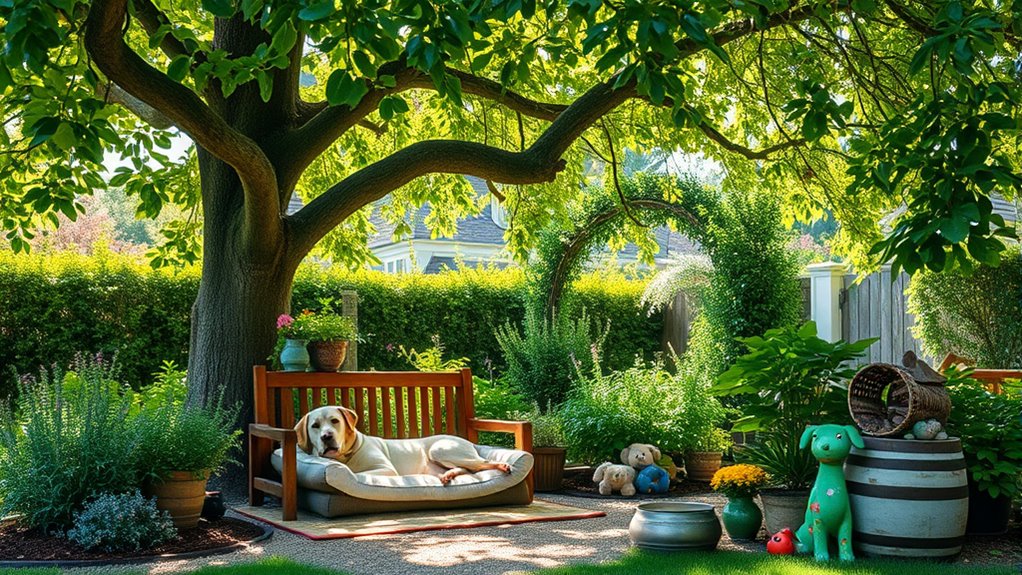
Creating shaded spots keeps your dog cool and comfortable during outdoor adventures. You can choose a sturdy shade tree, set up a portable canopy, or add mulch and ground cover for extra relief. Each option helps your pup relax safely in your garden.
Shade Tree Selection
Have you considered selecting the right shade trees to make your garden more dog-friendly? Proper trees can create cool spots for rest and boost outdoor scenting opportunities. Choose species that provide ample shade without dropping harmful fruits or leaves. Well-placed trees can also serve as natural barriers for dog agility exercises, encouraging safe play areas. When selecting trees, think about your dog’s activity needs and comfort. Consider trees with sturdy branches for resting, and avoid those with toxic or sharp parts. Properly positioned shade trees enhance outdoor experiences and make your garden inviting.
- Opt for non-toxic, sturdy trees like maples or oaks
- Plant trees strategically to maximize shade and scent trails
- Ensure branches are safe for dogs to rest or perch on
Portable Canopy Options
Portable canopies offer a flexible way to create shady spots and comfortable rest areas in your dog-friendly garden. A portable shelter provides instant relief from the sun, giving your dog a cool place to relax. When considering canopy installation, choose a sturdy frame and weather-resistant fabric for durability. Set up your canopy in high-traffic or sunny areas to maximize shade coverage. You can easily move the canopy as needed, making it ideal for seasonal changes or different outdoor activities. Keep in mind, proper anchoring is essential to prevent tipping in wind. With these options, you can quickly transform your garden into a comfortable retreat for your dog, ensuring they enjoy the outdoors safely and comfortably.
Mulch and Ground Cover
Mulch and ground cover are essential for establishing shaded spots and cozy resting areas in your dog-friendly garden. They help keep the soil moist, reduce weeds, and improve garden pest control, making the environment safer for your pup. Use organic mulches like wood chips or straw to avoid harmful chemicals and support composting techniques that enrich your soil. Ground cover plants, such as creeping thyme or clover, provide comfortable, cool surfaces your dog can enjoy. Be mindful of any plants that might be toxic to dogs. Regularly check for pests and replace mulch as needed to maintain a safe, inviting space. Proper ground cover also minimizes soil erosion, creating a stable, attractive area for your dog to relax and play.
Install Dog-Friendly Water Features

Adding a dog-friendly water feature to your garden can provide both entertainment and hydration for your furry friend. A garden pond designed with shallow edges and non-toxic materials offers a safe spot for your dog to splash and play. Guarantee the pond is easy to access and clean to prevent debris buildup. Alternatively, a water fountain can be a great addition, providing fresh, flowing water that encourages your dog to drink more often. Choose a fountain with a stable base and quiet operation to keep it inviting and safe. Avoid deep or complex water features that could pose safety risks. Regularly check for any hazards or leaks, and keep the area around the water feature clean to promote safe, enjoyable playtime for your dog.
Incorporate Durable and Safe Garden Furniture
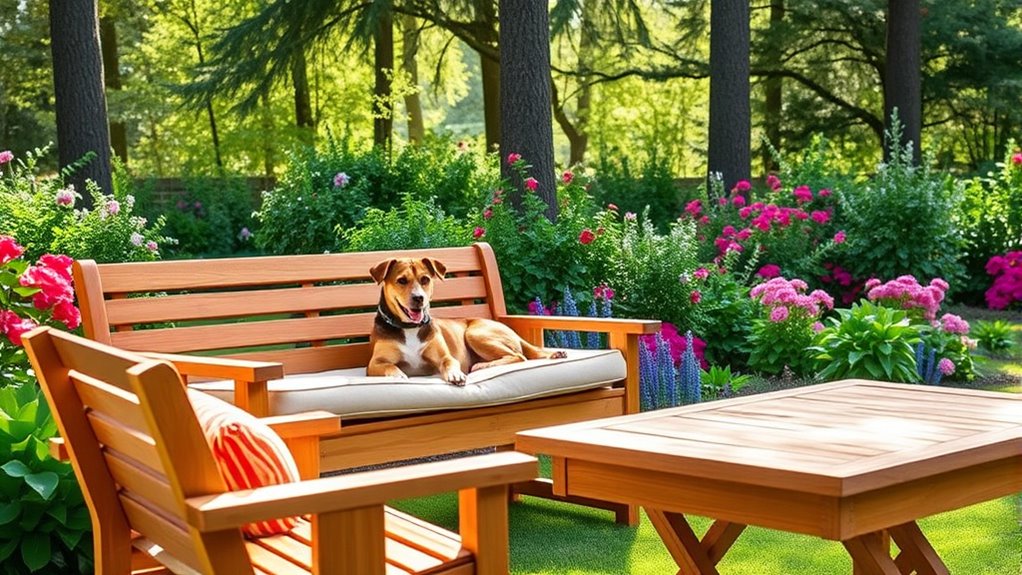
When choosing garden furniture, pick pieces made from weather-resistant materials to withstand the elements. Make sure finishes are non-toxic so your dog stays safe if they chew or lick. Finally, select sturdy, stable designs that won’t tip over easily during playful or energetic moments.
Choose Weather-Resistant Materials
Choosing weather-resistant materials for your garden furniture guarantees that your outdoor space remains inviting and safe for your dog year-round. Durable materials withstand rain, sun, and temperature changes, reducing maintenance and avoiding hazards. When planning your garden layout, consider furniture that resists rust, rot, and fading. Proper soil preparation helps prevent instability and damage from heavy or shifting furniture. To ensure longevity, select:
- Teak or cedar wood, which resist moisture and pests
- Powder-coated aluminum or steel for rust resistance
- Synthetic wicker designed for outdoor use
These choices keep your garden safe and inviting, reducing the need for frequent replacements. By focusing on weather-resistant options, you’ll create a sturdy, pet-friendly space that endures seasonal elements without compromising safety or aesthetics.
Prioritize Non-Toxic Finishes
To guarantee your garden remains safe for your dog, prioritize non-toxic finishes on all outdoor furniture. Using non toxic finishes ensures that harmful chemicals won’t leach into your garden environment or pose health risks to your pet. Look for pet safe paints specifically designed for outdoor use, as these provide durability while remaining safe for animals. Avoid furniture with lead-based or solvent-heavy coatings, which can be toxic if ingested or chewed. Instead, choose finishes labeled as non-toxic or eco-friendly, and verify they’re suitable for outdoor conditions. Applying these finishes creates a safer space for your dog to explore and relax without exposure to hazardous chemicals. Prioritizing non-toxic finishes is a simple but essential step in making your garden truly pet-friendly.
Opt for Sturdy, Stable Designs
Selecting garden furniture that is sturdy and stable guarantees your dog can move safely and comfortably throughout your outdoor space. Durable furniture prevents tipping or breaking, reducing the risk of injury. Opt for materials like treated wood, metal, or heavy-duty plastic that withstand weather and pet activity. When planning your garden, consider how furniture placement affects access to garden pest control areas and composting for pets, ensuring safety and convenience.
- Choose furniture with non-slip feet for stability
- Avoid sharp edges or fragile pieces that could break
- Regularly inspect and maintain furniture for safety and durability
Keep Toxic Plants Out of Reach
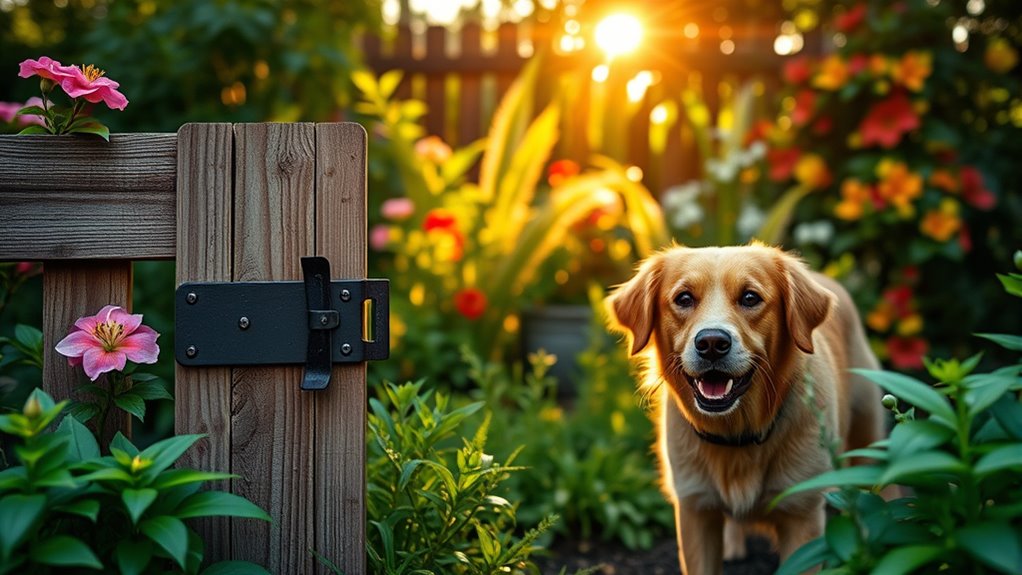
Have you ever wondered how to keep your curious dog safe from toxic plants in your garden? The key is to keep those plants out of reach. Many common garden plants pose serious risks due to plant toxicity, so it’s essential to be proactive. Use barriers like fences or plant cages to restrict access to harmful species. Consider planting pet-safe alternatives away from play areas. When you’re designing your garden, place toxic plants in elevated containers or behind locked gates. Regularly check that these barriers remain secure, especially if your dog is energetic or clever. By staying vigilant and managing plant placement, you can prevent accidental ingestion and protect your pet’s safety. Keeping toxic plants out of reach is a simple but crucial step toward a safe, dog-friendly garden.
Regularly Inspect and Maintain Your Garden for Safety

Regularly inspecting and maintaining your garden is essential for keeping it safe for your dog. By staying vigilant, you can identify hazards like garden pests or compromised plants that may harm your pet. Focus on effective garden pest control to prevent toxic insects or fungi from spreading. Also, prioritize soil nutrient management to ensure healthy, safe plants and reduce the risk of harmful weeds.
Regular garden checks prevent pests and ensure safe, healthy plants for your dog.
- Check for signs of pest infestations and treat promptly
- Remove any toxic plants or debris that could be dangerous
- Regularly test and amend soil to maintain proper nutrients and prevent unhealthy plant growth
Maintaining a clean, healthy garden minimizes risks and creates a safe outdoor space for your dog to explore and enjoy. Regular inspections help catch problems early, keeping your garden safe and pet-friendly.
Frequently Asked Questions
How Can I Train My Dog to Avoid Garden Plants?
To train your dog to avoid garden plants, start with consistent dog training by using positive reinforcement when they stay away from plants. Use plant deterrents like unpleasant scents or textures to discourage unwanted behavior. Establish boundaries and redirect your dog’s attention with toys or commands. Over time, your dog will learn to avoid the plants, making your garden a safe space for both of you.
What Signs Indicate My Dog Is Exposed to Garden Toxins?
When you suspect your dog has been exposed to garden toxins, it’s like a red flag waving. Watch for signs of plant toxicity, such as vomiting, diarrhea, drooling, or difficulty breathing. Behavioral changes like lethargy or confusion can also be clues. If you notice any of these symptoms, act quickly. Early detection can make a big difference in your dog’s recovery, so don’t delay seeking veterinary care.
Are There Specific Landscaping Tools Safe for Dog-Friendly Gardens?
When choosing landscaping tools, look for non-toxic tools and dog-safe equipment to guarantee your pet’s safety. You should avoid sharp or rusted tools that could harm your dog and opt for those made from non-toxic materials. Using non-toxic tools minimizes risks and keeps your garden a safe space for your furry friend. Always verify that your equipment is marked as dog-safe to prevent accidental injuries or exposure to harmful substances.
How Often Should I Check My Garden for Potential Hazards?
Your garden is like a bustling city, so you should check it daily for hazards. Regular seasonal hazard checks help you spot potential dangers early, like toxic plants or sharp tools. Incorporate garden pest prevention by inspecting for pests each week. By staying vigilant, you guarantee your furry friend stays safe and happy, and your garden remains a beautiful, hazard-free paradise. Don’t wait—make these checks part of your routine!
Can I Grow Edible Plants Safely Alongside My Dog?
Yes, you can grow edible plants safely alongside your dog, but you should take precautions. Practice garden pest control without harmful chemicals, and guarantee composting safety by avoiding toxic substances. Keep plants that are safe for dogs nearby, and monitor your pet to prevent accidental ingestion of harmful items. Regularly check your garden for hazards and maintain a clean, secure space to enjoy fresh produce with your furry friend.
Conclusion
By following these tips, you’re setting the stage for a garden where your dog can thrive and play safely. It’s all about creating a space where man’s best friend can enjoy the outdoors without a hitch. Remember, a little effort goes a long way—think of it as laying a solid foundation for endless happy moments together. With your careful planning, your garden will be a paradise where both you and your furry friend can enjoy the great outdoors to the fullest.

